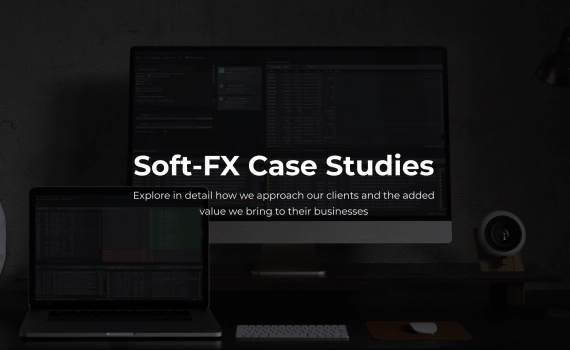Read more about the objectives behind the creation of our own TickTrader Trading Platform.
August 14, 2023
On this page
The financial technology landscape is rapidly evolving, with white-label trading platforms emerging as a pivotal component for businesses aiming to expand their offerings without incurring the high costs and time associated with developing proprietary solutions.
White-label software allows companies to rebrand and sell a developer's product as their own, providing a fast track to market entry and the ability to focus on customer acquisition and service.
August 14, 2023
White-label trading platforms are bespoke solutions that enable institutions, financial brokers, and fintech startups to offer trading services under their brand.
These platforms are developed by specialized firms and are designed to be customizable, scalable, and integrated seamlessly with existing services.
By adopting white-label solutions, businesses can leverage state-of-the-art technology to deliver a comprehensive trading experience to their clients.
White-label trading platforms come equipped with a range of features designed to support the trading process, including advanced charting tools, risk management systems and support for multiple asset classes.
These features are essential for providing a robust and user-friendly trading experience.
The adoption of white-label platforms offers numerous benefits, from reduced development costs and time to market to the ability to focus on core business activities such as marketing and customer support.
End-users benefit from a seamless trading experience, supported by advanced technology and a wide range of trading tools.
At its core, the white-label business model involves a partnership between two companies: the producer and the marketer. The producer develops the product, while the marketer rebrands and sells it as their own.
This model allows marketers to offer additional services without the need for significant investment in product development.
In the context of trading platforms, the white-label model allows financial service providers to offer a trading platform under their brand, enabling them to enter the market quickly and efficiently.
November 30, 2023
Selecting the right white-label trading platform requires careful consideration of several factors, including the platform's features, scalability, security measures, and the provider's reputation and support services.

Exploring case studies of successful white-label platform implementations can provide valuable insights into what makes a white-label partnership work and how to avoid common pitfalls.
Check out our case studies to see if our solutions can answer your needs.
Learn moreCustomization is crucial for creating a unique brand identity and user experience. A well-customized platform can help differentiate a company from its competitors and foster brand loyalty among users.
Creating a unique user experience involves more than just aesthetic customization. It includes tailoring the platform's functionality to meet the specific needs of your target audience, offering personalized support, and constantly updating the platform based on user feedback.
Understanding the technology behind white-label platforms is essential for ensuring they are secure, scalable, and capable of integrating with other services
This section explores the technical foundations of these platforms, including the use of APIs, cloud computing, and data encryption.
Security is paramount in the trading world, necessitating robust encryption and data protection measures.
Scalability ensures the platform can grow with your business, and seamless integration with other tools and services enhances the overall trading experience.

Regulatory compliance is a critical aspect of running a white-label trading platform. This section provides an overview of the regulatory landscape for trading platforms and the steps businesses need to take to ensure compliance.
Managing a white-label trading platform comes with its set of challenges, including keeping up with technological advancements, ensuring regulatory compliance, and managing client expectations.
This section outlines strategies to overcome common challenges, such as investing in continuous training, engaging in proactive regulatory planning, and fostering a customer-centric approach.
Contact us to arrange a call or even a product demo if you have such a request.
 Contact us
Contact us
What is a white-label trading platform?
A white-label trading platform is a software solution developed by a third party, which companies can purchase and brand as their own. It allows businesses to offer trading servi their clients without having to develop the platform from scratch.
How do white-label solutions benefit businesses?
White-label solutions offer businesses a quick and cost-effective way to enter the market with a fully functional trading platform. Benefits include reduced development time and costs, the ability to focus on core business functions, and the flexibility to customize and scale the platform as needed.
What factors should I consider when choosing a white-label platform?
Key factors to consider include the platform’s functionality, customization options, scalability, security features, ease of integration with other tools, provider’s reputation, and the level of customer support offered.
How can I customize a white-label trading platform for my brand?
Customization can range from branding elements, such as logos and color schemes, to more complex modifications like adding unique features or custom integrations. Work closely with the platform provider to understand the extent of customization possible.
What technical aspects should I prioritize in a white-label solution?
Prioritize aspects such as platform security, scalability to handle user growth, integration capabilities with other software or tools, and the use of modern, robust technologies that ensure a seamless and efficient trading experience.
Are there regulatory considerations for launching a white-label trading platform?
Yes, regulatory compliance is critical. This includes adhering to financial regulations specific to the markets you operate in, ensuring data protection standards are met, and maintaining transparent trading practices. Consult with legal experts to navigate these requirements.
What challenges might I encounter, and how can they be mitigated?
Challenges include staying compliant with evolving regulations, ensuring the platform remains technologically competitive, and managing client expectations. Mitigation strategies include continuous monitoring of regulatory changes, investing in technology upgrades, and maintaining open lines of communication with clients.
Can you provide examples of successful white-label platform implementations?
While specific company names are not provided here, successful implementations often feature platforms that have been customized to fit the unique needs of the business, offer a robust set of trading tools and features, and maintain high standards of security and regulatory compliance.
How do I ensure security and compliance with financial regulations?
Ensure that your platform implements robust cybersecurity measures, such as encryption, two-factor authentication, and regular security audits. Compliance with financial regulations can be ensured by staying updated with legal requirements, conducting regular compliance audits, and possibly consulting with regulatory experts.
What are the potential costs associated with a white-label trading platform?
Costs can vary widely depending on the complexity of the platform, the level of customization required, ongoing maintenance, and support needs. Initial setup fees, monthly or annual licensing fees, and additional costs for customization and updates are common. It's important to discuss all potential costs with the provider upfront to ensure transparency and budget accordingly.